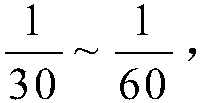A method for analyzing the nonlinear vibration characteristics of a turbine mechanical blade considering the friction and collision of a damping structure
A nonlinear vibration and turbomachinery technology, applied in special data processing applications, instruments, electrical digital data processing, etc., can solve problems such as low computing efficiency and achieve the effect of improving computing efficiency
- Summary
- Abstract
- Description
- Claims
- Application Information
AI Technical Summary
Problems solved by technology
Method used
Image
Examples
Embodiment Construction
[0027] see figure 1 As shown, the present invention provides a method for analyzing nonlinear vibration characteristics of turbomachinery blades considering damping structure friction, comprising the following steps:
[0028] 1) According to the geometric structure of the actual turbine blade-disc, establish a three-dimensional model of the turbine blade-disc, and divide the three-dimensional model to form an overall finite element model of the turbine blade-disc;
[0029] 2) Determine the contact interface and friction node pairs of each damping structure of the blade-disk finite element model, and perform static contact analysis. The specific steps are:
[0030] (2.1) Determine the number p of friction node pairs at the contact interface of each damping structure of the blade-disk finite element model. The contact interface should include all friction interfaces, including the contact surface of adjacent blade shrouds and the contact surface between lamellae .
[0031] see...
PUM
 Login to View More
Login to View More Abstract
Description
Claims
Application Information
 Login to View More
Login to View More - R&D
- Intellectual Property
- Life Sciences
- Materials
- Tech Scout
- Unparalleled Data Quality
- Higher Quality Content
- 60% Fewer Hallucinations
Browse by: Latest US Patents, China's latest patents, Technical Efficacy Thesaurus, Application Domain, Technology Topic, Popular Technical Reports.
© 2025 PatSnap. All rights reserved.Legal|Privacy policy|Modern Slavery Act Transparency Statement|Sitemap|About US| Contact US: help@patsnap.com



